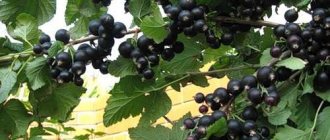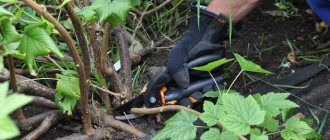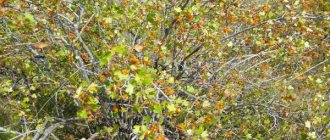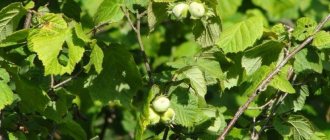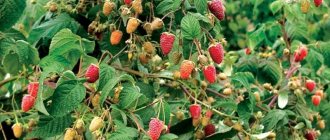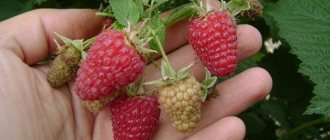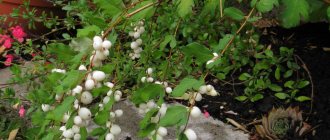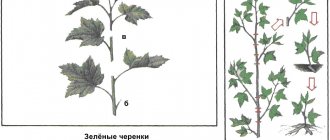» Gardening » Currants » Autumn cuttings of currants - propagation rules
0
2191
Article rating
There are different ways to obtain new planting material from berry bushes. Let's look at how to propagate currants by cuttings, why it is better to carry out this procedure in the fall, and what care is needed after planting.
- Aftercare
- Transplanting to a garden bed
- Planting scheme
- Technology
- Caring for annual seedlings
- Cultivation by layering
Autumn cuttings of currants - propagation rules
Pros and cons of autumn propagation of currants by cuttings in the fall
There are two types of bush propagation: cuttings and layering. The first method has many advantages. These include:
- Currant cuttings allow you to obtain an almost unlimited amount of material from the bush.
- The new bush retains all the qualities and characteristics that the mother plant had. Plus, you can choose the best shoots that give a good harvest.
- The resulting planting material can be planted immediately into the future growth site (school) under suitable conditions.
- The technology for growing currants using cuttings is much simpler than using seeds and cuttings. This does not damage the root system of an adult plant.
- In autumn, sap flow slows down, so seedlings have a better chance of surviving the winter. They take root easier.
- In autumn, moisture loss decreases, and in spring intensive development of the root system begins.
- High resistance to aggressive environments is formed.
The disadvantage of planting by cuttings is that it is impossible to accurately predict the result and guarantee the survival of the planting material. When planted by layering, seedlings have a better chance of taking root.
Benefits of cuttings
There are two vegetative methods of propagating currants - layering and cuttings. Growing using the first method gives a 100% survival rate, cuttings with a probability of rooting up to 90%, but is considered more preferable.
This is due to several factors:
- The ability to grow several plants at the same time with all the varietal characteristics of the mother bush. You get a new variety, which is impossible when propagated by layering.
- You can prepare and receive planting material at any time of the year, even in winter. In the cold season, lignified shoots are used, in spring and summer - green cuttings.
- There is no need to replant the mother bush; it can initially be planted in a permanent place. When grown by layering, this cannot be done, since the root system of the plant receives severe stress after such a procedure, and as a result, it may die.
Rules for taking cuttings
Preparation of planting material plays an important role. The viability of seedlings depends on this. The following rules will help you root without problems:
- Operate only with disinfected equipment. Always treat cuttings on the bush with garden varnish.
- The right time for cuttings is the end of August, September or the beginning of October. During this period, it is advisable to have time to cut and plant seedlings.
- For propagation, choose young shoots of the 1st or 2nd order that have not yet become woody. They shouldn't be completely green, but they shouldn't break when bent.
- Mother bushes must be healthy and fruitful. Therefore, mark suitable branches in the summer.
- For successful planting, cuttings 15-20 cm long with a pair of leaves are suitable. Prepare 18-20 pieces, so more will take root.
- Cut the shoots correctly: along the upper edge 0.5 cm above the bud at an angle of 50-60 degrees, and along the bottom in a straight line 2 cm above the bud. Roots will appear in the internode.
- To strengthen the cuttings, place them in a solution with a root growth stimulator for 12 hours. They will grow faster and stronger. For stimulation, drugs such as Kornevin, Heteroauxin, Indolylbutyric acid and others are suitable.
When is the best time to take cuttings?
What are the dates for planting currants in the fall? The best time is September and October. This is a good time when currant cuttings will go smoothly.
During this period, the process of sap flow slows down, which means that during sudden freezing there will be no ruptures inside the plant body. The sap consists of water, which when frozen turns into ice and increases in volume by up to 10 percent.
Cuttings of red currants in autumn
Red currant can be propagated by one-year-old woody cuttings. They differ from old shoots by having a lighter stem color. Cut the branch right to the root. The mother shoot can grow on shoots that are 2-3 years old.
Cut the cuttings 15-20 cm long and 5-8 mm thick. The middle part of the branch is suitable for this. The cuttings should have 3-5 healthy buds. Cut the top part 1-2 cm from the buds, and the bottom at an angle of 45-60 degrees, 5 mm from the bud.
The best time to plant cuttings is spring and autumn. But autumn is preferable, since the soil will have time to settle under the future bush, and the plant will get stronger over the winter. In spring, the bush will begin to grow immediately, thanks to the already established root structure. Therefore, plant in open ground in the first half of October.
Features of land preparation
Do not neglect the recommendations; the area must be leveled. The quality of future watering of currants will depend on this.
It is very important to remove all parts of the roots of other plants from the soil. It is also necessary to get rid of perennial weeds. They can take away the necessary nutrients, and young currant seedlings will not be able to fully develop.
It is recommended to dig up the soil using the bayonet of a shovel. Also during this procedure it is necessary to apply the necessary fertilizers, as if mixing the soil with fertilizer.
Methods for rooting cuttings
Rooting cuttings is an important step in the formation of the future currant bush. There are three options for rooting seedlings:
- in a specially prepared substrate;
- rooting in a solution of a root growth stimulator;
- in plain water until the cuttings release roots.
The third option is the simplest and most accessible. Even inexperienced gardeners can handle it. Place the cuttings in a container of water and keep for two weeks. The water needs to be changed daily. After the roots appear (after 10 days) and are sufficiently developed, transplant the seedlings into open ground.
The second option is similar to the first, the difference is that a growth stimulator is dissolved in water. There are many special drugs in stores. In this case, roots appear much faster. Then the young plants are also transplanted into open ground.
You can see that on the right, where the root formation stimulator was used, the root system is more developed
The most difficult option is growing in a special substrate. You can prepare it yourself from:
- turf land;
- aspen or alder sawdust;
- vermiculite;
- water.
Steam the sawdust to destroy all pathogenic bacteria and fungi. Combine 1 part turf soil with 3 parts sawdust. Place vermiculite in the bottom of the container and pour the substrate on top. Stick the cuttings 2-3 cm into the soil. Water the seedling regularly; the soil should not dry out.
There is another option: first germinate the roots in water, and then plant them in the soil mixture to develop the root system until spring.
But carry out all three types of germination at home in a warm room with a temperature of at least 20 degrees.
Reproduction in summer
Summer cuttings of red currants are carried out in the second half of summer, mainly in the middle or second half of August. For successful rooting, it is necessary that the air temperature drop below +25ºС, and that it is possible to maintain high humidity inside the greenhouse.
It is also necessary that the soil temperature in the greenhouse be higher than the air temperature, at least by a few degrees.
To root red currant shoots, build a greenhouse, a covered bed, or use a greenhouse.
How to prepare a shelter for rooting?
For planting and rooting red currants, prepare a bed and a greenhouse. This can be a small shelter 10-20 cm high. You can also propagate currants (root cuttings) in the shaded part of a large greenhouse.
The space in the rooting zone should be constantly moist. The moisture content in the soil should be 80-90%, and in the air - 90-95%. The presence of a shelter makes it possible to create and maintain the necessary conditions for the rooting of currant cuttings.
Note: individual currant branches can be rooted under plastic bottles. However, mass rooting of a large number of chibouks requires the construction of a greenhouse or greenhouse.
In summer, a shaded place is chosen for propagation of currants by rooting. This could be the thick shadow of a large tree (walnut), the shadow of a house wall or a fence.
Under the shelter, the soil is prepared - fertilized, loosened, and, if necessary, dug with sand to ensure air flow to the developing roots.
After the preparatory work, they begin to plant the prepared red currant cuttings.
Rooting red currants: choosing cuttings
Red currants are propagated by cuttings in the summer using vegetative shoots of the current year and annual shoots of the previous year. For successful rooting, it is necessary to take a strong, healthy young shoot with a sufficient amount of cambium and mature wood.
For rooting, take the middle part of the shoot. They do not take the poorly matured top and the lower part that has managed to coarse. Young green shoots and old perennial shoots are also not suitable for rooting.
So, the best cuttings for rooting are:
- A one-year-old shoot - its bark is brown and smooth (unlike 2-year-old and older shoots, which have a rough bark).
- This year's young shoot - usually, such shoots are formed in the upper part of the main skeletal branches; they have light brown, smooth, shiny bark.
The shoot thickness for rooting must be at least 5 mm. The optimal cross-sectional dimensions of the cuttings are 6-8 mm. Such a cutting has enough cambium - the substance from which roots will form. As well as an adequate supply of nutrients.
Technology for preparing cuttings
The preparation technology is as follows:
- Cut annual shoots 6-8 mm thick. You can also cut the current year's shoots to a suitable thickness.
- Leaves are cut from the prepared branches.
- Cuttings from 4 to 6 buds long are cut from the middle part of red currant shoots. The upper edge of the cutting is cut at a distance of 0.5-1 cm from the uppermost bud. The lower edge is 2 cm from the lower bud.
- The upper cut is made perpendicular. The lower one is oblique. This increases the cutting area and the root formation area. An oblique cut will produce more roots and a more powerful root system.
The prepared cuttings are soaked in a solution of a root formation stimulator and planting begins.
How to plant cuttings?
The technology for planting red currant cuttings is as follows:
- The cuttings are buried into the ground by 2-4 buds. There should be 2 buds above the soil surface.
- The direction of deepening the cuttings is at an angle to the ground surface of about 45º (diagonally).
- If the soil is loose, the cuttings easily sink into the ground. If planting material is planted without digging up the soil, then the recesses for the cuttings are made with a metal rod of suitable diameter.
- The soil under the planted branches is well watered.
- The bed is covered with polyethylene. When planting in a greenhouse or greenhouse, additional cover is not used. Limited to watering.
Planting currant cuttings in the ground
Planting is possible in two ways:
- plant immediately in open ground and organize a greenhouse around the seedlings;
- do preliminary root germination at home.
The second option allows you to get stronger shoots that have a better chance of surviving the winter. Plant prepared and germinated cuttings in the ground in October so that they have time to adapt to the environment and gain a foothold before wintering.
Planting after root germination
An important step in this process is preparing the soil in the garden plot. To do this you need:
- dig up future sites for planting seedlings;
- form holes up to 20-30 cm deep;
- add fertilizers: ash, humus or manure, superphosphate, peat in the amount of half a bucket per 1 sq. m.;
- cover the fertilizer with a layer of soil;
- add sand for drainage and cover with soil again.
Plant in warm, not hot weather, preferably in the absence of rain. The process includes the following steps:
- Place plants 1 m apart from each other unless you plan to replant them in the spring. If there is a transplant in the spring, then make the distance 10-15 cm. To do this, dig trenches along the thread.
- It is important to place the seedlings at an angle, as this promotes the formation of a more developed root system.
- Deepen the neck of the root system by 5-7 cm, this will stimulate additional shoots.
- Pour in settled water. Repeat the procedure after 3-5 days.
- After planting, compact the soil and mulch with manure, non-woven material or straw.
- The above-ground part of the seedling should have 2-3 buds so that the main amount of nutrients goes to the development of the root system. In addition, the upper part grows stronger already at a temperature of +7-8 degrees, while the roots grow at +16-18 degrees. An underdeveloped system will not allow the plant to fully develop, and subsequently you will not get a good harvest.
- Before frost, the seedling needs to be hilled up and additionally insulated with 5-8 cm of mulch.
Choosing a landing site
Choose a place for permanent cultivation depending on the variety and type of currant. Suitable for black berries:
- Open spaces with light shade, well ventilated and humidified. Avoid swampy, low-lying areas.
- The berry grows on neutral heavy and medium loamy soils.
Grow red and white currants on:
- open sunny place, slightly dry;
- light sandy and loamy soils.
Planting cuttings after cutting
When planting cuttings immediately after cutting in open ground, the technology is maintained with the difference that a small greenhouse is built around the school. Stretch plastic film over the planting site. Use wooden or metal pegs as a frame. Press the edges with bricks. A special microclimate will be formed inside; condensation will appear on the walls, so there will be no need to water additionally. As a rule, roots appear in 10-14 days. This method is suitable for black and red currants.
Basic rules for planting currant bushes
To plant currant bushes, choose flat, dry, well-lit land with fertile soil:
- The soil is carefully dug up, loosened, mixed with organic and mineral substances.
- In the prepared area, planting holes are dug, no more than 30 centimeters deep and wide.
- The distance between plantings is maintained within 1 meter, between ridges up to 2 meters.
- A fertile soil mixture is placed in the hole, a seedling is placed on top, and the rhizomes are carefully spread throughout the hole.
- The plant is tilted at an angle of 45 degrees and dug in with earth, lightly compacted, the bush is tied to a supporting structure and moistened generously with warm water.
To facilitate further plant care, the soil around the bushes is mulched with humus or dry grass.
Planting care
Blackcurrant propagates well from cuttings, but at first it requires careful care. Pay attention to the following points:
- Mandatory weed removal is required. You can even treat the soil with herbicides.
- A month after planting, carry out the first fertilizing. To do this, use conventional fertilizers based on phosphorus, potassium and nitrogen. Dilute a teaspoon of fertilizer in 5 liters of water and water the plant. You can feed in the spring, but by the end of summer you need to stop.
- It is imperative to loosen the soil around the seedlings, especially after watering and rain.
- Before wintering, insulate the seedlings with several layers of mulch of 5-7 cm.
- In spring, open the plant when the air temperature warms up to 12-15 degrees. It also needs to be loosened and watered.
To get a healthy and strong plant, treat the bush against pests and diseases in the spring.
Soil selection
Before planting a certain variety of currant, it is important to consider what type of soil is on the site. Light soil is suitable for white and red currants. Loamy soil is also suitable. Neutral soil is suitable for black berries.
Once the seedlings have been prepared by the gardener, you can begin preparing the site for planting them. First of all, it needs to be leveled. Then clear the area of weeds that are firmly rooted there. These weeds interfere with the normal development of planted seedlings.
After cleaning the area, you can begin to feed the soil and then dig it up. Compost or humus is used as top dressing. You can also add phosphorus-potassium fertilizers.
If the gardener decides to plant the cuttings immediately in a permanent place in the fall, then the holes are dug in advance. This is done two weeks before disembarkation. When planting seedlings in spring, the holes are also prepared in the fall.
